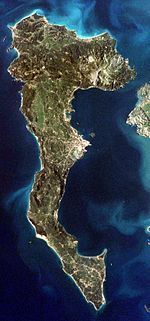Corfu incident
| Corfu Incident | |||||||
|---|---|---|---|---|---|---|---|
 Corfu, one of the Ionian Islands | |||||||
| |||||||
| Belligerents | |||||||
|
|
| ||||||
The Corfu Incident was a 1923 diplomatic crisis between the Kingdom of Greece and the Kingdom of Italy.
Background
There was a boundary dispute between Greece and Albania. The two nations took their dispute to the Conference of Ambassadors. The Conference of Ambassadors created a commission to determine the boundary, which was authorized by the League of Nations to settle the dispute. Several countries (including Italy) provided small detachments of soldiers to assist the commission in carrying out the survey. General Enrico Tellini became the chairman of the commission. From the outset of the negotiations, the relations between Greece and the commission were negative. Eventually the Greek delegate openly accused Tellini of working in favour of Albania's claims.[1]
The incident in Greece
On August 27, in 1923 the Italian general, Enrico Tellini, and three of his assistants were murdered by unknown assailants at Kakavia within Greek territory.[2] The four victims included Enrico Tellini, Major Luigi Corti, Lieutenant Luigi Bonacini and an Albanian interpreter. None of the victims were robbed.[3]
They were attacked, according to some sources, by Greek nationalists;[4] while according to the official statement of Greece, Tellini was assassinated by Albanian bandits.[5]
This article needs additional citations for verification. (February 2010) |
Italian reaction
Italy sent an ultimatum to Greece on August 29, 1923, demanding 50 million lire in reparations and execution of the killers. Greece was unable to identify the killers, so Italian forces bombarded and occupied the Greek island of Corfu on August 31, 1923, killing at least fifteen civilians. The ulterior motive for the invasion was Corfu's strategic position at the entrance of the Adriatic Sea.[citation needed]
Resolution
Greece appealed to the League of Nations, which initially condemned the Italian occupation. The dispute was handed over to the Conference of Ambassadors, and Italy and Greece agreed to be bound by its decision. The Conference largely followed the nominal Italian demands, ordering Greece to apologise and pay reparations, a decision that Greece accepted. Italian forces left Corfu on September 27, 1923.
In Corfu during the first quarter of the 20th century, many Italian operas were performed at the Municipal Theatre of Corfu. This tradition came to a halt following the Corfu incident. After the bombardment the theatre featured Greek operas as well as Greek theater performances by distinguished Greek actors such as Marika Kotopouli and Pelos Katselis.
See also
- Stylianos Gonatas, Greek Prime Minister during the incident
- Benito Mussolini, Italian Prime Minister during the incident
References
- ^ Brecher, Michael; Wilkenfeld, Jonathan (1997). A study of crisis. University of Michigan Press. p. 583. ISBN 0472108069.
- ^ Michael Brecher & Jonathan Wilkenfeld: A study of crisis
- ^ Massock, Richard (2007). Italy from Within. READ BOOKS. ISBN 1406720976.
- ^ Italy in the last fifteen hundred years: a concise history By Reinhold Schumann page 298 ([1])
- ^ Albania's Captives. Pyrrhus J. Ruches. Argonaut, 1965 p. 120 "He had no trouble recognizing three of them. They were Major Lepenica, Nevruz Belo and Xhellaledin Aqif Feta, alias Daut Hohxa."
